Research on Fingerprint Map Construction and Real-Time Update Method Based on Indoor Landmark Points
Abstract
1. Introduction
- (1)
- Landmark points are used for the first time in fingerprint mapping.
- (2)
- An automatic landmark point recognition method is developed.
- (3)
- A novel fingerprint map database structure is developed.
- (4)
- A real-time and relatively accurate fingerprint map updates to achieve reliable indoor positioning.
2. Time Varying Experiment of Fingerprint Maps
2.1. WIFI Fingerprint Signal Fluctuation Experiment
2.2. The Impact of WiFi Fingerprint Signal Fluctuation on Positioning Accuracy
3. New Fingerprint Map Based on Indoor Landmark Points
3.1. Traditional Fingerprint Map Layer
3.2. Landmark Point Fingerprint Map Layer
4. Real-Time Updating of Landmark Point Fingerprint Maps
4.1. Recognition Module
4.2. Update Module
5. Experiment and Results
5.1. Experiment Scenario and Setting
5.2. Result
6. Conclusions
Author Contributions
Funding
Data Availability Statement
Conflicts of Interest
References
- Laoudias, C.; Moreira, A.; Kim, S.; Lee, S.; Wirola, L.; Fischione, C. A survey of enabling technologies for network localization, tracking, and navigation. IEEE Commun. Surv. Tutor. 2018, 20, 3607–3644. [Google Scholar] [CrossRef]
- Shams, F.P.; Amirhossein, F.; Javad, R.; Alireza, B. A survey on indoor positioning systems for IoT-based applications. IEEE Internet Things J. 2022, 9, 7680–7699. [Google Scholar]
- Tanaka, K.M. Cosmic-ray arrival time indoor navigation. P. Roy. Soc. A-Math. Phy. 2025, 481, 20240346. [Google Scholar] [CrossRef]
- Khaqan, M.; Steve, H. Passive indoor visible light positioning system using deep learning. IEEE Internet Things J. 2021, 8, 14810–14821. [Google Scholar] [CrossRef]
- Mayer, P.; Magno, M.; Benini, L. Self-Sustaining ultrawide-band positioning system for event-driven indoor localization. IEEE Internet Things J. 2024, 11, 1272–1284. [Google Scholar] [CrossRef]
- Li, Z.; Zhao, X.H.; Zhao, Z.L.; Braun, T. WiFi-RITA positioning: Enhanced crowdsourcing positioning based on massive noisy user traces. IEEE Trans. Wirel. Commun. 2021, 20, 3785–3799. [Google Scholar] [CrossRef]
- Ashu, T.; Rani, S.; Jose, B.; Amr, T.; Kadry, S. An improved WiFi sensing based indoor navigation with reconfigurable intelligent surfaces for 6G enabled IoT network and AI explainable use case. Future Gener. Comput. Syst. 2023, 149, 294–303. [Google Scholar]
- Ferrero-Lopez, A.; Gallego, A.J.; Lozano, M.A. Bluetooth low energy indoor positioning: A fingerprinting neural network approach. Internet Things 2025, 31, 101565. [Google Scholar] [CrossRef]
- Wang, J.; Mi, X.; Chen, W.; Luo, H.; Mansour, A.; Li, Y.; Yu, Y.; Weng, D. Tightly coupled bluetooth enhanced GNSS/PDR system for pedestrian navigation in dense urban environments. IEEE Trans. Instrum. Meas. 2024, 73, 9519713. [Google Scholar] [CrossRef]
- Pan, H.; Qi, X.G.; Liu, M.L.; Liu, L.F. Indoor scenario-based UWB anchor placement optimization method for indoor localization. Expert Syst. Appl. 2022, 205, 117723. [Google Scholar] [CrossRef]
- Santoro, L.; Nardello, M.; Brunelli, D.; Fontanelli, D. UWB-based indoor positioning system with infinite scalability. IEEE Trans. Instrum. Meas. 2023, 72, 1005711. [Google Scholar] [CrossRef]
- Yu, B.G.; Fan, G.W.; Luo, Y.; Sheng, C.Z.; Gan, X.L.; Huang, L.; Rong, Q. Multi-source fusion positioning algorithm based on pseudo-satellite for indoor narrow and long areas. Adv. Space Res. 2021, 68, 4456–4469. [Google Scholar] [CrossRef]
- Li, S.; Wang, J.C.; Yu, B.G.; Xing, H.T.; Wang, S. A deep learning-based approach for pseudo-satellite positioning. IET Commun. 2024, 18, 1140–1150. [Google Scholar] [CrossRef]
- Aitor, A.F.; Alvaro, D.C.; Luis, L.J.; Antoni, P.N.; Ruben, G.V.; Alfredo, G.V. Seamless mobile indoor navigation with VLP-PDR. IEEE Sens. J. 2024, 24, 11504–11514. [Google Scholar]
- Basso, M.; Martinelli, A.; Morosi, S.; Sera, F. A real-time GNSS/PDR navigation system for mobile devices. Remote Sens. 2021, 13, 1567. [Google Scholar] [CrossRef]
- Bhat, C.; Maisto, M.A.; Khankhoje, U.K.; Solimene, R. Subsurface radar imaging by optimizing sensor locations in spatio-spectral domains. IEEE Trans. Geosci. Remote Sens. 2024, 61, 4505310. [Google Scholar] [CrossRef]
- Xu, T.X.; Wang, X.P.; Su, T.; Wan, L.T.; Sun, L. Vehicle location in edge computing enabling IoTs based on bistatic FDA-MIMO radar. IEEE Access 2021, 9, 46398–46408. [Google Scholar] [CrossRef]
- Karkar, A.G.; Somaya, A.M.; Kunhoth, J.; Bouridane, A. CamNav: A computer-vision indoor navigation system. J. Supercomput. 2021, 77, 7737–7756. [Google Scholar] [CrossRef]
- Xu, Y.; Liu, T.Q.; Sun, B.; Zhang, Y.; Khatibi, S.; Sun, M.X. Indoor vision/INS integrated mobile robot navigation using multimodel-based multifrequency kalman filter. Math. Probl. Eng. 2021, 2021, 6694084. [Google Scholar] [CrossRef]
- Aminah, N.S.; Ichwanda, A.S.; Djamal, D.D.; Budiharto, Y.B.W.; Budiman, M. A low-cost indoor navigation and tracking system based on Wi-Fi-RSSI. Wirel. Pers. Commun. 2024, 136, 1791–1809. [Google Scholar] [CrossRef]
- Chen, J.; Zhou, B.; Bao, S.; Liu, X.; Gu, Z.; Li, L.; Zhao, Y.; Zhu, J.; Li, Q. A data-Driven inertial navigation/bluetooth fusion algorithm for indoor Localization. IEEE Sens. J. 2022, 22, 5288–5301. [Google Scholar] [CrossRef]
- Lin, H.Y.; Zhan, J.R. GNSS-denied UAV indoor navigation with UWB incorporated visual inertial odometry. Measurement 2023, 206, 112256. [Google Scholar] [CrossRef]
- Wang, M.M.; Berkane, S.; Tayebi, A. Nonlinear observers design for vision-aided inertial navigation systems. IEEE Trans. Autom. Control 2022, 67, 1853–1868. [Google Scholar] [CrossRef]
- Sun, M.; Wang, Y.J.; Wang, Q.X.; Chen, G.L.; Li, Z.K. Smartphone-based WiFi RTT/RSS/PDR/Map indoor positioning system using particle filter. IEEE Trans. Instrum. Meas. 2024, 74, 9501115. [Google Scholar] [CrossRef]
- Chen, J.; Song, S.J.; Yu, H.H. An indoor multi-source fusion positioning approach based on PDR/MM/WiFi. AEU-Int. J. Electron. Commun. 2021, 135, 153733. [Google Scholar] [CrossRef]
- El-Sheimy, N.; Li, Y. Indoor navigation: State of the art and future trends. Satell. Navig. 2021, 2, 7. [Google Scholar] [CrossRef]
- Jin, R.; Zhou, J.; Hu, J.; Guo, P.; Cai, C.; Wu, Y. Toward practical lightweight passive human tracking using WiFi sensing. IEEE Internet Things J. 2023, 10, 13769–13783. [Google Scholar] [CrossRef]
- Gao, W.; Zhan, X.Q.; Yang, R. INS-aiding information error modeling in GNSS/INS ultra-tight integration. GPS Solut. 2024, 28, 35. [Google Scholar] [CrossRef]
- Qin, H.L.; Du, Y.S.; Li, J.T.; Xu, Z.B.; Liang, H.Y. A dynamic initialization method for LEO/INS integrated positioning. IEEE Trans. Instrum. Meas. 2024, 73, 8503912. [Google Scholar] [CrossRef]
- Jiang, C.; Chen, Y.; Chen, C.; Jia, J.; Sun, H.; Wang, T.; Hyyppä, J. Smartphone PDR/GNSS integration via factor graph optimization for pedestrian navigation. IEEE Trans. Instrum. Meas. 2022, 71, 8504112. [Google Scholar] [CrossRef]
- Li, Z.K.; Zhao, L.; Qin, C.B.; Wang, Y.F. WiFi/PDR integrated navigation with robustly constrained Kalman filter. Meas. Sci. Technol. 2020, 31, 084002. [Google Scholar] [CrossRef]
- Zhang, M.; Jia, J.; Chen, J.; Deng, Y.; Wang, X.; Aghvami, A.H. Indoor localization fusing WiFi with smartphone inertial sensors using LSTM networks. EEE Internet Things J. 2022, 8, 13608–13623. [Google Scholar] [CrossRef]
- Han, Y.; Yu, S.M.; Kim, S.L.; Ko, S.W. Exploiting user mobility for WiFi RTT positioning: A geometric approach. IEEE Internet Things J. 2021, 8, 14589–14606. [Google Scholar] [CrossRef]
- Huang, B.Q.; Xu, Z.D.; Jia, B.; Mao, G.Q. An online radio map update scheme for WiFi fingerprint-based localization. IEEE Internet Things J. 2019, 6, 6909–6918. [Google Scholar] [CrossRef]
- Lim, J.S.; Jang, W.H.; Yoon, G.W.; Han, D.S. Radio map update automation for WiFi positioning systems. IEEE Commun. Lett. 2013, 17, 693–696. [Google Scholar] [CrossRef]
- Niu, X.; Zhang, Z.; Wang, A.; Liu, J.; Liu, S. Online learning-based WIFI radio map updating considering high-dynamic environmental factors. IEEE Access 2020, 7, 110074–110085. [Google Scholar] [CrossRef]
- Du, X.Q.; Liao, X.W.; Liu, M.M.; Gao, Z.Z. CRCLoc: A crowdsourcing-based radio map construction method for WiFi fingerprinting localization. IEEE Internet Things J. 2022, 9, 12364–12377. [Google Scholar] [CrossRef]
- Li, Q.; Liao, X.W.; Li, A.; Valaee, S. Automatic indoor radio map construction and localization via multipath fingerprint extrapolation. IEEE Trans. Wirel. Commun. 2023, 22, 5814–5827. [Google Scholar] [CrossRef]
- Tao, Y.; Zhao, L. AIPS: An accurate indoor positioning system with fingerprint map adaptation. IEEE Internet Things J. 2022, 9, 3062–3073. [Google Scholar] [CrossRef]
- Zhang, P.; Chen, R.; Li, Y.; Niu, X.; Wang, L.; Li, M.; Pan, Y. A localization database establishment method based on crowdsourcing inertial sensor data and quality assessment criteria. IEEE Internet Things J. 2018, 5, 4764–4777. [Google Scholar] [CrossRef]
- Si, H.; Guo, X.; Ansari, N.; Chen, C.; Duan, L.; Huang, J. Environment-aware positioning by leveraging unlabeled crowdsourcing data. IEEE Internet Things J. 2024, 11, 16436–16449. [Google Scholar] [CrossRef]
- Zhou, B.; Ma, W.; Li, Q.; El-Sheimy, N.; Mao, Q.; Li, Y.; Gu, F.; Huang, L.; Zhu, J. Crowdsourcing-based indoor mapping using smartphones: A survey. ISPRS J. Photogramm. Remote. Sens. 2021, 177, 131–146. [Google Scholar] [CrossRef]
- Zhou, B.; Li, Q.; Mao, Q.; Tu, W.; Zhang, X.; Chen, L. ALIMC: Activity landmark-based indoor mapping via crowdsourcing. IEEE Trans. Intell. Transp. Syst. 2015, 16, 2774–2785. [Google Scholar] [CrossRef]
- Lashkari, B.; Rezazadeh, J.; Farahbakhsh, R.; Sandrasegaran, K. Crowdsourcing and sensing for indoor localization in IoT: A review. IEEE Sens. J. 2019, 19, 2408–2434. [Google Scholar] [CrossRef]
- Lee, S.H.; Kim, W.Y.; Seo, D.H. Automatic self-reconstruction model for radio map in Wi-Fi fingerprinting. Expert Syst. Appl. 2022, 192, 116455. [Google Scholar] [CrossRef]
- Rajab, A.M.; Wang, B. IWFUCIA: An integrated model for Wi-Fi fingerprints radio map updating and localization on changed impact analysis. Pervasive Mob. Comput. 2023, 91, 101784. [Google Scholar] [CrossRef]
- Chen, Q.Y.; Wang, B. FinCCM: Fingerprint crowdsourcing, clustering and matching for indoor subarea localization. IEEE Wirel. Commun. Lett. 2015, 4, 677–680. [Google Scholar] [CrossRef]
- Jiang, C.; Chen, Y.; Chen, C.; Chen, S.; Meng, Q.; Bo, Y.; Hyyppa, J. Cooperative smartphone GNSS/PDR for pedestrian navigation. IEEE Trans. Circuits Syst. II Express Briefs 2023, 70, 2301–2305. [Google Scholar] [CrossRef]
- Yu, J.G.; Na, Z.Y.; Liu, X.; Deng, Z.A. WiFi/PDR-integrated indoor localization using unconstrained smartphones. EURASIP J. Wirel. Commun. Netw. 2019, 2019, 41. [Google Scholar] [CrossRef]
- Zou, H.; Chen, C.L.; Li, M.; Yang, J.; Zhou, Y.; Xie, L.; Spanos, C.J. Adversarial learning-enabled automatic WiFi indoor radio map construction and adaptation with mobile robot. IEEE Internet Things J. 2020, 7, 6946–6954. [Google Scholar] [CrossRef]
- Xue, M.; Sun, W.; Yu, H.; Tang, H.; Lin, A.; Zhang, X.; Zimmermann, R. Locate the mobile device by enhancing the WiFi-based indoor localization model. IEEE Internet Things J. 2019, 6, 8792–8803. [Google Scholar] [CrossRef]
- Bahl, P.; Padmanabhan, V.N. RADAR: An in-building RF-based user location and tracking system. In Proceedings of the IEEE INFOCOM 2000. Conference on Computer Communications. Nineteenth Annual Joint Conference of the IEEE Computer and Communications Societies (Cat. No.00CH37064), Tel Aviv, Israel, 26–30 March 2000; pp. 775–784. [Google Scholar]
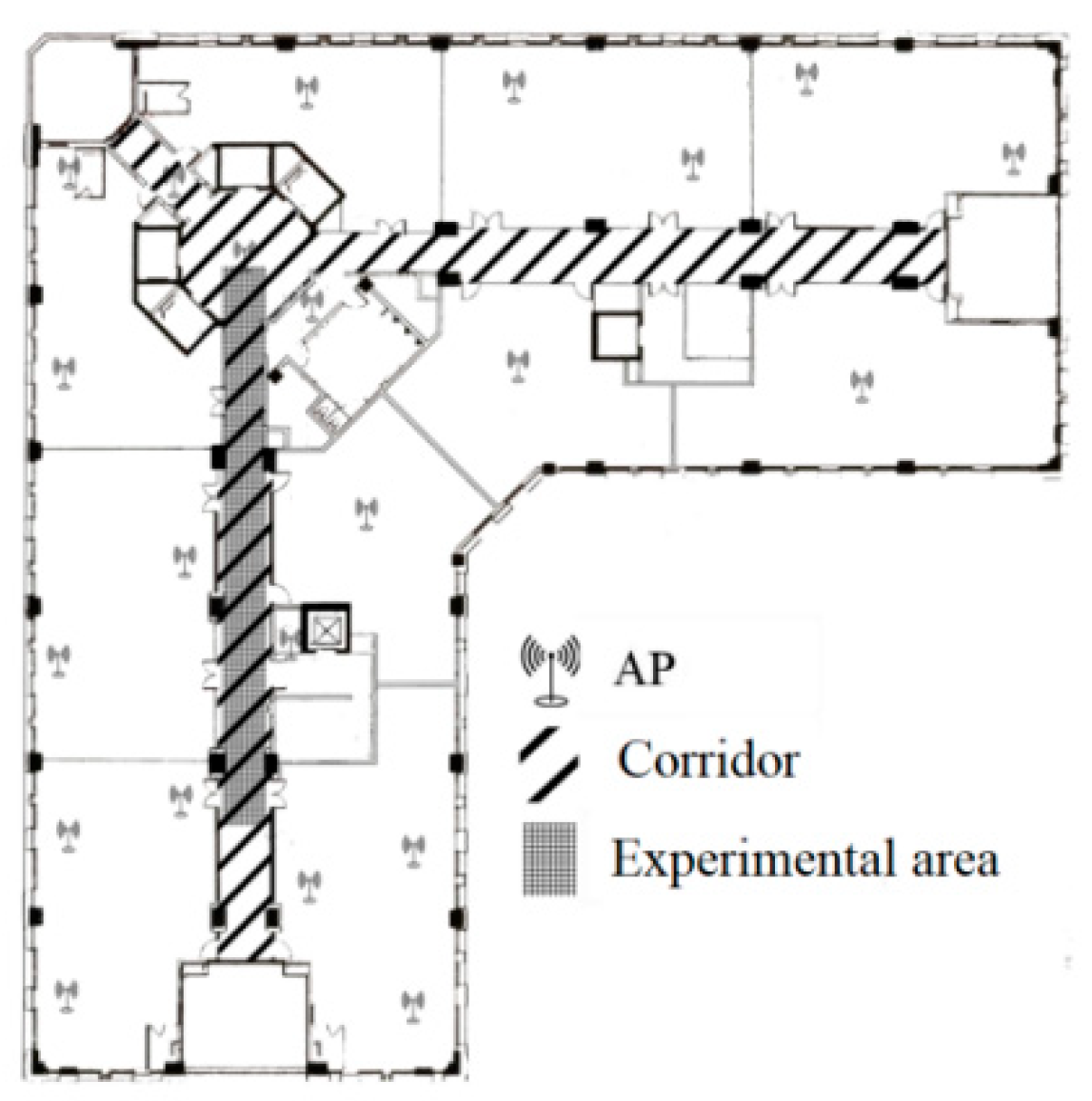
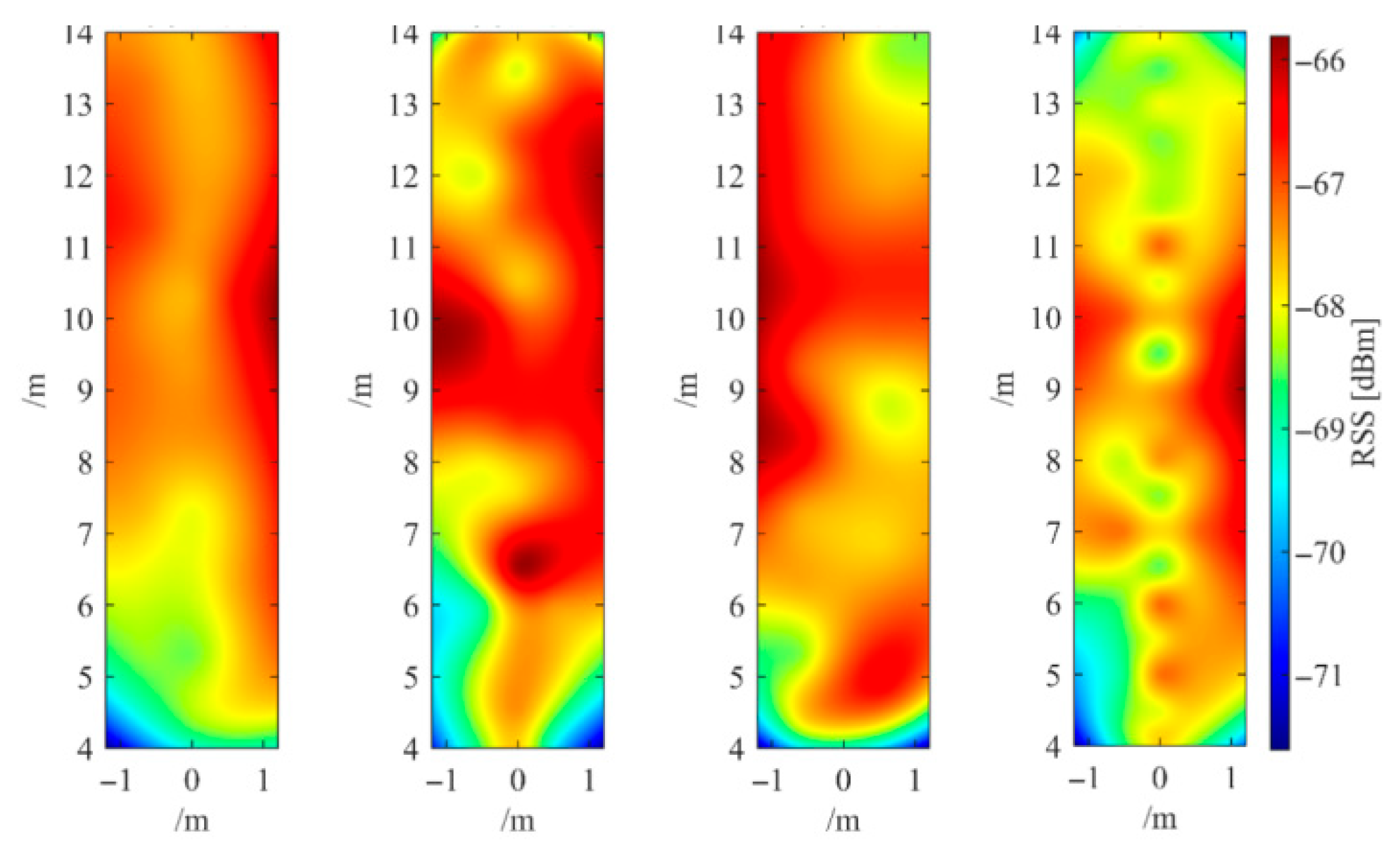
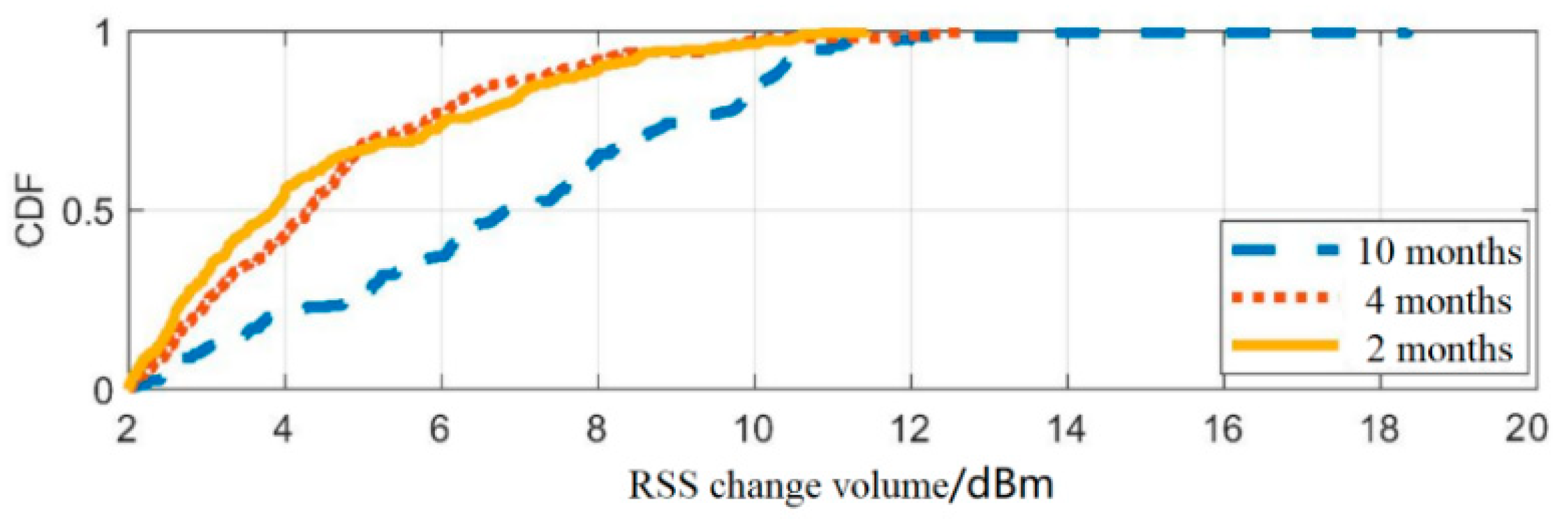

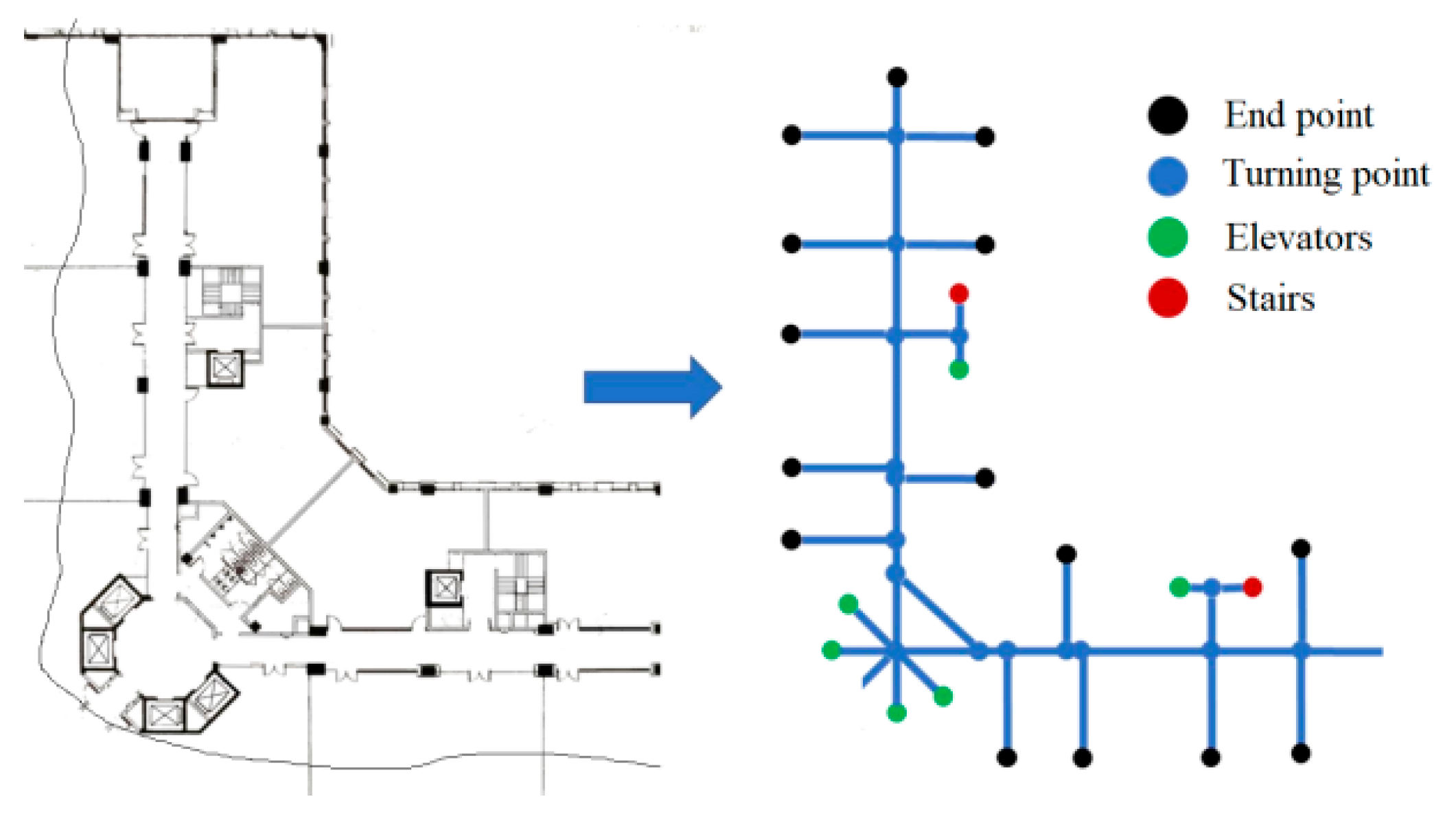

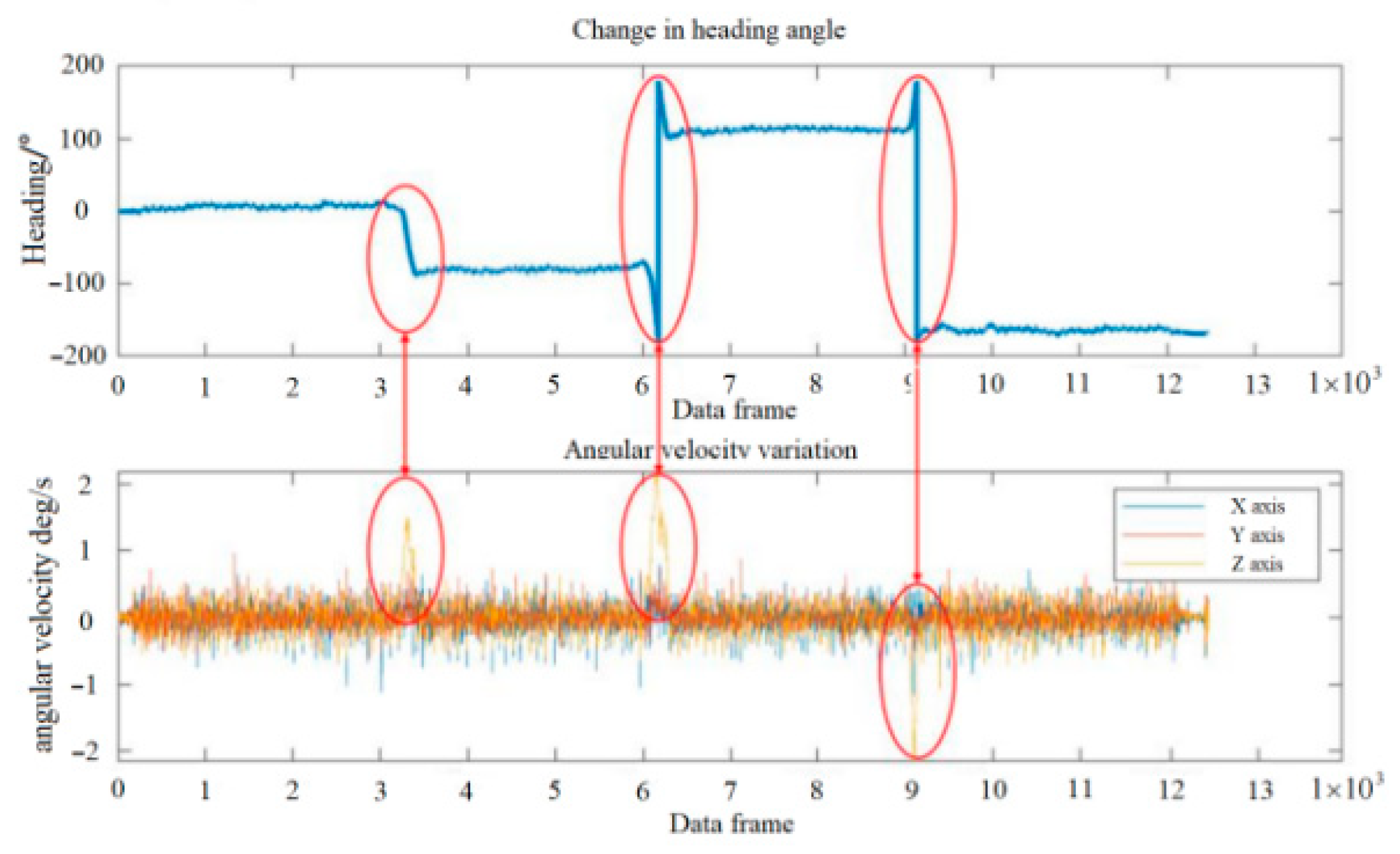
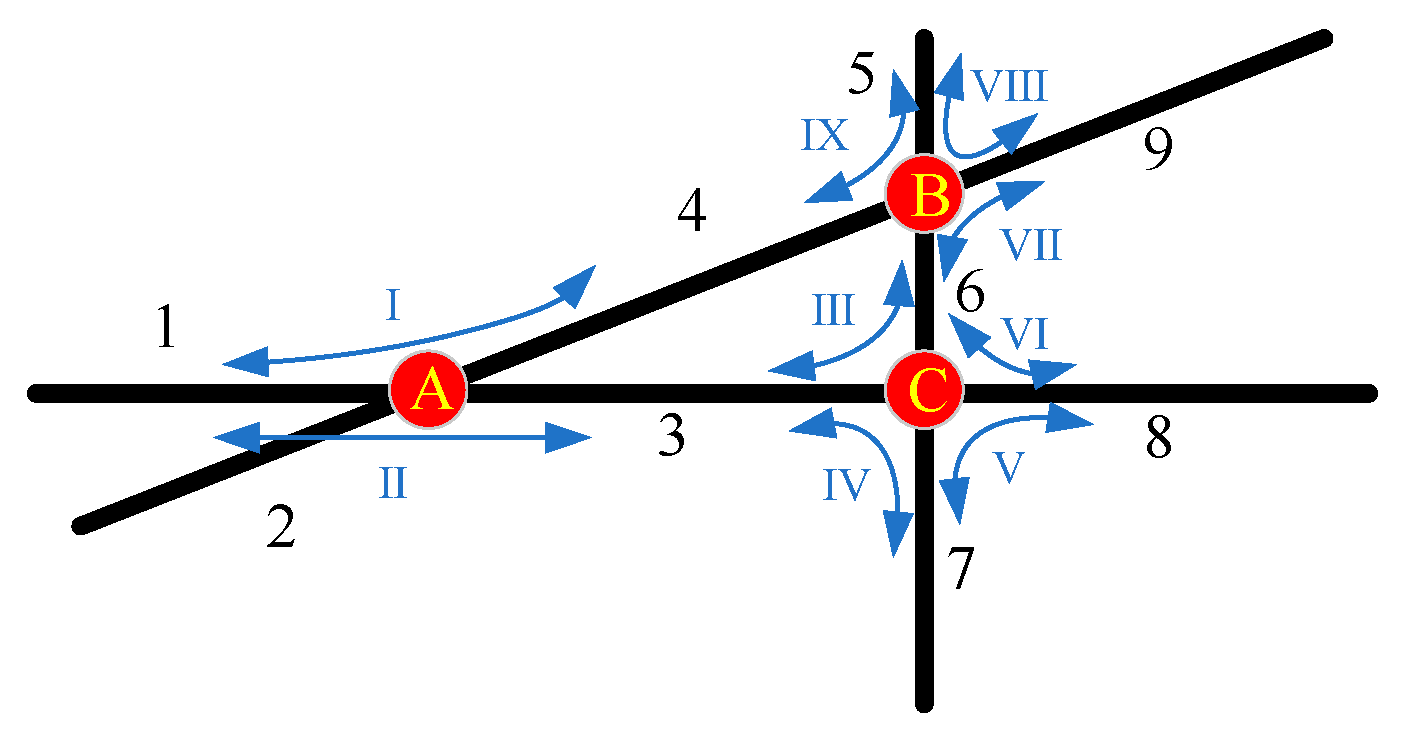

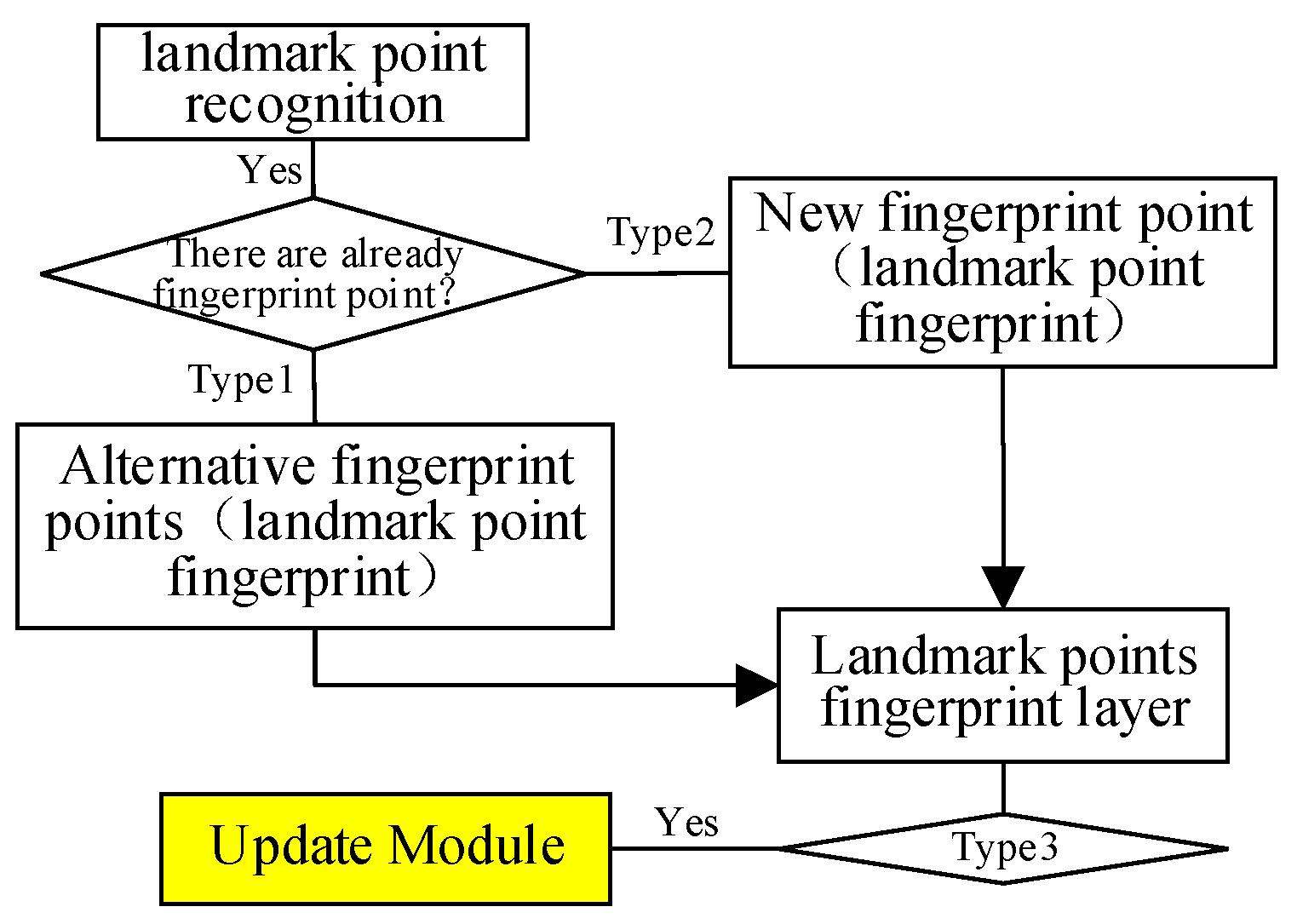
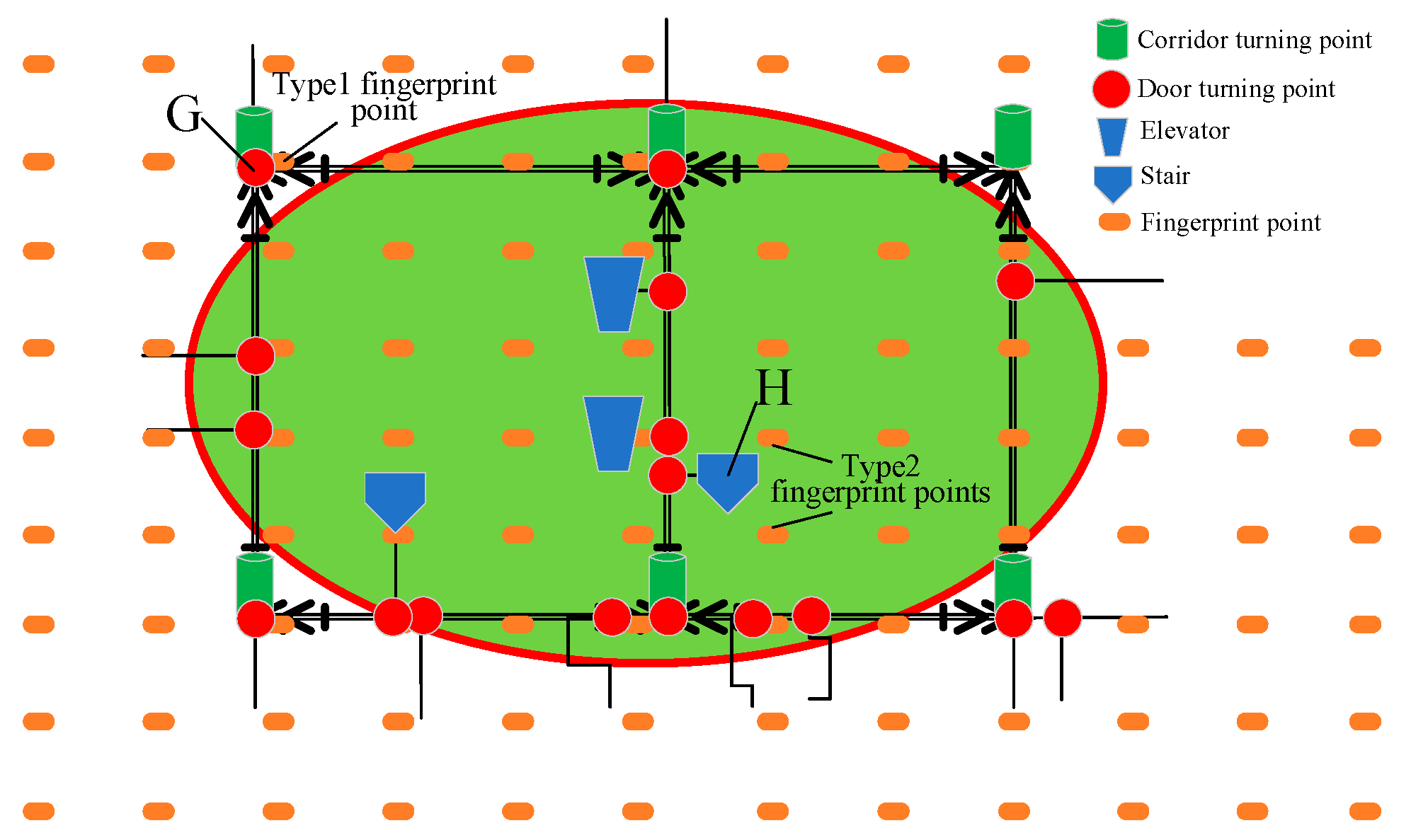



| AP | MAC | Test Points | |||
|---|---|---|---|---|---|
| 1 [dBm] | 2 [dBm] | 6 [dBm] | |||
| 1 | *:66:f1 | NaN | −61.19 | … | NaN |
| 2 | *:68:35 | −56.98 | NaN | … | −63.85 |
| 3 | *:69:54 | NaN | NaN | … | NaN |
| … | … | … | … | … | … |
| 39 | *:ac:62 | NaN | −62.10 | … | NaN |
| 40 | *:ac:63 | −63.95 | NaN | … | NaN |
| AP | MAC | Test Points | |||
|---|---|---|---|---|---|
| 1 [dBm] | 2 [dBm] | 6 [dBm] | |||
| 1 | *:66:f1 | −58.35 | −54.79 | … | −59.43 |
| 2 | *:68:35 | −57.88 | NaN | … | NaN |
| 3 | *:69:54 | NaN | −63.56 | … | NaN |
| … | … | … | … | … | … |
| 39 | *:ac:62 | −53.54 | −50.02 | … | −59.87 |
| 40 | *:ac:63 | −60.00 | −56.29 | … | −62.97 |
| AP | MAC | Test Points | |||
|---|---|---|---|---|---|
| 1 [dBm] | 2 [dBm] | 6 [dBm] | |||
| 1 | *:66:f1 | −59.89 | −57.54 | … | NaN |
| 2 | *:68:35 | −57.98 | NaN | … | −60.01 |
| 3 | *:69:54 | NaN | −62.24 | … | NaN |
| … | … | … | … | … | … |
| 39 | *:ac:62 | −56.36 | −50.60 | … | NaN |
| 40 | *:ac:63 | −53.65 | −59.53 | … | −61.70 |
| AP | MAC | Test Points | |||
|---|---|---|---|---|---|
| 1 [dBm] | 2 [dBm] | 6 [dBm] | |||
| 1 | *:66:f1 | −57.00 | −65.22 | … | −62.56 |
| 2 | *:68:35 | NaN | NaN | … | NaN |
| 3 | *:69:54 | NaN | NaN | … | NaN |
| … | … | … | … | … | … |
| 39 | *:ac:62 | −58.66 | NaN | … | NaN |
| 40 | *:ac:63 | −55.34 | −62.22 | … | −56.40 |
| Interval Time [Mon.] | Mean Value [dBm] | Median [dBm] | Standard Deviation [dBm] | 80% Percentile [dBm] |
|---|---|---|---|---|
| 2 | 2.35 | 1.69 | 2.11 | 3.85 |
| 4 | 2.82 | 2.47 | 2.48 | 5.36 |
| 10 | 4.95 | 5.01 | 3.03 | 8.27 |
| Interval Time [Mon.] | Mean Value [m] | Median [m] | Standard Deviation [m] | 80% Percentile [m] |
|---|---|---|---|---|
| 10 | 1.97 | 1.56 | 1.49 | 4.26 |
| 4 | 1.23 | 1.14 | 0.75 | 1.41 |
| 2 | 0.84 | 0.66 | 0.57 | 1.01 |
| Current | 0.63 | 0.50 | 0.49 | 0.71 |
| Field Name | Data Type | Numeric Range |
|---|---|---|
| No. | short int | |
| rss[i] | double | |
| Type | short int | 1~6 |
| Area | short int | / |
| Heading | double | 60~120 (°) |
| Trajectory | Turning Points | ||||||||
|---|---|---|---|---|---|---|---|---|---|
| 1 | 2 | 3 | 4 | 5 | 6 | 7 | 8 | ||
| 1 | Crossing | 3 | 3 | 1 | 2 | 3 | 3 | 5 | 5 |
| recognition | 3 | 3 | 1 | 2 | 3 | 3 | 5 | 5 | |
| 2 | Crossing | 11 | 11 | 3 | 2 | 10 | 6 | 14 | 15 |
| recognition | 11 | 11 | 3 | 2 | 10 | 6 | 14 | 15 | |
| Fingerprint Map | Mean Value [m] | Median [m] | Standard Deviation [m] | 80% Percentile [m] |
|---|---|---|---|---|
| ISFMap | 0.87 | 0.67 | 0.58 | 1.24 |
| AUFMap | 0.75 | 0.74 | 0.46 | 1.12 |
| CSFMap | 0.63 | 0.50 | 0.49 | 0.71 |
| Fingerprint Map | Mean Value [m] | Median [m] | Standard Deviation [m] | 80% Percentile [m] |
|---|---|---|---|---|
| ISFMap | 2.87 | 2.32 | 2.07 | 3.67 |
| AUFMap | 1.37 | 1.49 | 0.77 | 1.67 |
| CSFMap | 0.73 | 0.66 | 0.59 | 1.09 |
| Fingerprint Map | Mean Value [m] | Median [m] | Standard Deviation [m] | 80% Percentile [m] |
|---|---|---|---|---|
| ISFMap | 3.57 | 3.44 | 3.03 | 7.32 |
| AUFMap | 1.23 | 1.09 | 0.70 | 1.46 |
| CSFMap | 0.63 | 0.50 | 0.49 | 0.71 |
Disclaimer/Publisher’s Note: The statements, opinions and data contained in all publications are solely those of the individual author(s) and contributor(s) and not of MDPI and/or the editor(s). MDPI and/or the editor(s) disclaim responsibility for any injury to people or property resulting from any ideas, methods, instructions or products referred to in the content. |
© 2025 by the authors. Licensee MDPI, Basel, Switzerland. This article is an open access article distributed under the terms and conditions of the Creative Commons Attribution (CC BY) license (https://creativecommons.org/licenses/by/4.0/).
Share and Cite
Zhu, Y.; Cheng, Y. Research on Fingerprint Map Construction and Real-Time Update Method Based on Indoor Landmark Points. Sensors 2025, 25, 5473. https://doi.org/10.3390/s25175473
Zhu Y, Cheng Y. Research on Fingerprint Map Construction and Real-Time Update Method Based on Indoor Landmark Points. Sensors. 2025; 25(17):5473. https://doi.org/10.3390/s25175473
Chicago/Turabian StyleZhu, Yaning, and Yihua Cheng. 2025. "Research on Fingerprint Map Construction and Real-Time Update Method Based on Indoor Landmark Points" Sensors 25, no. 17: 5473. https://doi.org/10.3390/s25175473
APA StyleZhu, Y., & Cheng, Y. (2025). Research on Fingerprint Map Construction and Real-Time Update Method Based on Indoor Landmark Points. Sensors, 25(17), 5473. https://doi.org/10.3390/s25175473






